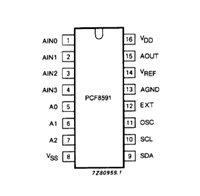AD5320
TERMINOLOGY
Relative Accuracy
Total Unadjusted Error
For the DAC, relative accuracy or integral nonlinearity (INL) is
a measure of the maximum deviation, in LSBs, from a straight
line passing through the endpoints of the DAC transfer
function. A typical INL vs. code plot can be seen in Figure 5.
Total unadjusted error (TUE) is a measure of the output error
considering all the various errors. A typical TUE vs. code plot
can be seen in Figure 7.
Zero-Code Error Drift
Differential Nonlinearity
This is a measure of the change in zero-code error with a
change in temperature. It is expressed in μV/°C.
Differential nonlinearity (DNL) is the difference between the
measured change and the ideal 1 LSB change between any two
adjacent codes. A specified differential nonlinearity of 1 LSB
maximum ensures monotonicity. This DAC is guaranteed
monotonic by design. A typical DNL vs. code plot can be seen
in Figure 6.
Gain Error Drift
This is a measure of the change in gain error with changes in
temperature. It is expressed in (ppm of full-scale range)/°C.
Digital-to-Analog Glitch Impulse
Digital-to-analog glitch impulse is the impulse injected into the
analog output when the input code in the DAC register changes
state. It is normally specified as the area of the glitch in nV
seconds and is measured when the digital input code is changed
by 1 LSB at the major carry transition (7FF Hex to 800 Hex); see
Figure 22.
Zero-Code Error
Zero-code error is a measure of the output error when zero
code (000 hex) is loaded to the DAC register. Ideally, the output
should be 0 V. The zero-code error is always positive in the
AD5320 because the output of the DAC cannot go below 0 V
due to a combination of the offset errors in the DAC and output
amplifier. Zero-code error is expressed in mV. A plot of zero-
code error vs. temperature can be seen in Figure 9.
Digital Feedthrough
Digital feedthrough is a measure of the impulse injected into
the analog output of the DAC from the digital inputs of the
DAC but is measured when the DAC output is not updated. It
is specified in nV seconds and measured with a full-scale code
change on the data bus, that is, from all 0s to all 1s and vice
versa.
Full-Scale Error
Full-scale error is a measure of the output error when full-scale
code (FFF Hex) is loaded to the DAC register. Ideally the output
should be VDD − 1 LSB. Full-scale error is expressed in percent
of full-scale range. A plot of full-scale error vs. temperature can
be seen in Figure 9.
Gain Error
This is a measure of the span error of the DAC. It is the
deviation in slope of the DAC transfer characteristic from ideal
expressed as a percent of the full-scale range.
Rev. C | Page 7 of 20






 STM32F030C6芯片介绍:主要参数分析、引脚配置说明、功耗及封装
STM32F030C6芯片介绍:主要参数分析、引脚配置说明、功耗及封装

 PCF8591数据手册解读:参数、引脚说明
PCF8591数据手册解读:参数、引脚说明

 一文带你了解ss8050参数、引脚配置、应用指南
一文带你了解ss8050参数、引脚配置、应用指南

 深入解析AD7606高性能多通道模数转换器:资料手册参数分析
深入解析AD7606高性能多通道模数转换器:资料手册参数分析
